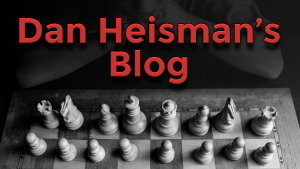Not "White to play and win"? Worthless?!
Occasionally I hear some intermediate level players protest that any problem that does not follow the normal "needs" of a chess game can't be helpful to your game. These "normal" concerns would include:
- White (Black) to play and win (if you are not 100% sure what this, or any other "normal" requirement means, check out Understanding Chess Puzzles)
- White to play and mate
- White to play and mate in N
- White to play and draw
Sometimes they even complain about "Mate in N", noting that any position where you can mate in N+1 in a game they would do so and not worry about Mate in N.
However, if we carry over this logic to other, physical, games that would similarly imply that anyone in a sport other than weightlifting (like American football) would never benefit from weight lifting, or any other training/exercise that is not directly their sport. That's nonsense of course, and the same applies to chess.
Everyone is different and, if a particular person has an aversion to "non-normal" chess problems and that aversion causes them to miss the benefits, so be it. If you are one of those, don't do these problems! But the average player, if he/she occasionally did such "board vision" problems, would probably benefit as I did when I was an improving player (for more on how I use the term "board vision" and its benefits, check out The Amazing Power of Board Vision).
At this point I need to clarify what type of problems I am discussing. For the moment, let's eliminate "fairy" problems where the pieces either move differently, or there are new pieces that move like a combination of knight-rook or knight-bishop, etc. But that still leaves a large class of problems where the pieces move exactly as they do in a regular chess game, but are now being asked to perform different tasks than the ones bulleted above. The possibilities are limitless and I am not an expert in this field, but this would include such problems as:
- Help mates
- Sui-mates
- Mate-avoidance
- Switcheroos (Coakley)
- Double Whammies (Coakley)
- Chess Mazes (Alberston & others - 350+ here)
- Construction (and game proofs)
- Retractors, etc.
Since in these problems the pieces move as they normally do in chess, you are strengthening one or more of your "chess muscles" when you do them, including your board vision, chess logic, tactical vision, etc. You are learning what the pieces can do, both individually and in concert.
For example, doing a knight tour, while not required in a real game, can help you spot how to get your knight from one place to another efficiently in a game, and more quickly spot possible knight forks. Similarly, practicing K&B&N vs. K (a problem which can occur in regular play) can clearly help your visualization and piece coordination skills even though that endgame is rare and may only occur once or twice in your lifetime, so getting a win in those situations instead of a draw would hardly affect your playing strength. But the point is that the side effects are clearly more beneficial than the direct effects of those one or two extra half points.
When I first started playing I did many of these "abnormal" problems. They were great challenges. One book that had some was Irving Chernev's interesting The Bright Side of Chess. Later non-trivial retrograde problems were popularized through Raymond Smullyan's The Chess Mysteries of Sherlock Holmes and Chess Mysteries of the Arabian Knights. Lately Jeff Coakley has introduced a whole new set of interesting puzzles for all ages and levels with Winning Chess Puzzles for Kids Vol 1 and especially Vol 2 (reviewed here, with some clever examples).
Here's a helpmate in 2 that GM Jonathan Rowson gives to his students to "help" them think outside the box. Helpmate: Black moves first; Black and White cooperate to mate Black in a specified number of moves. Solution at the end of this article:
So if you think those puzzles may not be for you or can't help you, that's probably a self-fulfilling prophecy - stay away! But if you believe they can't help anyone become a good player, that's clearly not true. They helped me and others in ways difficult to measure but easy to explain. Plus there's the added benefit: find some types of problems that you like and they can be loads of fun and challenge, and isn't that much of what we want from a game or puzzle? Try some and see your "chess logic" - and in the long run probably your results - improve  .
.
Solution to the Rowson help-mate: For Black to start by under-promoting to a knight or bishop to set up a White mate with the well-known pattern 2.Nf6 and 3.Qg8# doesn't work: 1...h1N 2.Nf6 and now both 2...Ng3 and 2...Nf2+ interfere with the mate. Ditto for 1...h1B 2.Nf6 and now 2...Bxg2 is the only legal move. So the solution is to abandon the Nf6/Qg8 pattern and go for 1...h1R+ 2.Qf1 Rxh7 3.Qf8# Cute!






